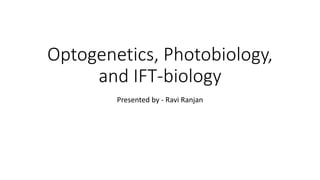
optogenetics photobiology and ift biology - ravi ranjan
- 1. Optogenetics, Photobiology, and IFT-biology Presented by - Ravi Ranjan
- 2. Optogenetics
- 4. optogenetics • Science of using light and light sensitive proteins into cells and its application. • Use of light to control cells in living tissue, that have been genetically modified to express light-sensitive ion channels and monitor the activities of individual neurons in living tissue.
- 5. How it all started? • Some microorganisms produce visible light gated proteins, which direcly regulate the flow of ions across plasma membrane. Bacteriorhodopsin being activated by visible light photons.(Stoeckenius and Oesterhelt, 1971;) • Response of Chlamydomonas reinhardtii in presence of light, protein that cause green algae to swim towards or away from light is a light sensitive channel . • Blue light causes the Channelrhodopsin to Open and +ve ions flood into cells and cause nerve cell to activate.(Hagemann, Negal et al.,2002;) • Similarly, use of Halorhodopsin from Natrosomonas pharonis to switch neurons off in presence of yellow/orange light.(Matsuno-yagi and /mukhota,1977;)
- 6. response of Chlamydomonas reinhardtii in absence and presence of light
- 7. Opening of ChannelRhodopsin2 in presence of blue light and generation of nerve impulse. ( Curtsy- https://www.ncbi.nlm.nih.gov/pubmed/.) Opening and Halorhodopsin in presence of yellow/orange light.
- 10. Applications • Optical stimulation of electrically excitable cells can be performed simply by light with high precision. • Targeting control tools to cells of interest and obtaining compatible readouts, and analysis of activities. • It can be used to study neurons involved in Epilepsy, Visual impairment, Anxiety, Schizophrenia, Parkinson’s disease and several other neurodegenerative diseases and may lead to a new treatment method.
- 11. Photobiology • Study of the interaction of light and the living organisms. • Sunlight is the most important element of our environment, since it is the ultimate source of energy. • Most of the energy from the sun reaches Earth in the form of • Visible light • Infrared radiation • A small amount of ultraviolet radiation • Organism interact with a particular range of the wavelength of light.
- 12. Light strikes the earth in rays of varying wavelengths. Long rays (infrared) are unseen but felt as heat. Intermediate length rays are visible as light. Shorter rays (ultraviolet) are also invisible
- 13. Properties Infrared Visible Ultra-violet Wavelengths longer than red light The different colors of light make up the visible spectrum. Wave lengths shorter than violet light It can be felt as heat Red has the longest wave length Can cause eye problems Used to warm food Violet has the shortest wave length Can cause skin damage
- 14. • There are various role of light in biological system :- Photosynthesis Photo morphogenesis Visual processing Photopriodism
- 15. Photoreceptors: • In cell biology: • Photoreceptor cell, a photosensitive cells(rod and cone) in the retina of vertebrate eyes. • Microbial photoreceptor, the photoreceptor organelle of a unicellular organism that allows for phototaxis. • In biochemistry: • Photoreceptor protein, a chromoprotein that responds to being exposed to a certain wavelength of light by initiating a signal transduction cascade. • Photopigment, an unstable pigment that undergoes a physical or chemical change upon absorbing a particular wavelength of light. • In technology: • Photodetector or photosensor, a device that detects light by capturing photons. • Electronic photoreceptor, a sensor that converts solar energy into electric energy.
- 16. Photoreceptor cells • A photoreceptor cell is a specialized type of neuron found in the retina that is capable of phototransduction. • There are currently three known types of photoreceptor cells in mammalian eyes: rods, cones, and photosensitive retinal ganglion cells. • Rod and cone cells contribute to visual system.
- 17. Differences between rod and cone cells.
- 18. Photoreceptor proteins Six well-characterized photoreceptor families function in Nature to mediate light-induced signal transduction: the Rhodopsins, phytochromes, xanthopsins, cryptochromes, phototropins, and BLUF proteins. Rhodopsins Ion channel protein Phytochromes Photopriodism Xanthopsins Carries trans-coumaric acid(a chromophore) Cryptochromes Flavin-based, opening of stomata Phototropins Flavin-based, UV A/ blue light receptor BLUF Flavin-based, present in PAC. Source: http://pubs.acs.org/doi/abs/10.1021/ar020219d
- 19. Properties of photoreceptors • Each photoreceptors exhibits absorption of different spectra. • Response depends upon- • No. of photon (rod cells needs less than cones). • Wavelength of light (colour and range for activation of photoreceptors). • Time of exposer to light .
- 20. Intraflagellar Transport • Eukaryotic cilia and flagella, including primary cilia and sensory cilia, are highly conserved organelles that project from the surfaces of many cells. The assembly and maintenance of these nearly ubiquitous structures are dependent on a transport system, known as ‘Intraflagellar transport' (IFT). • The bi-directional Movement of non-membrane-bound particles from the cell body out to the tip of the cilium or flagellum, and then returns them to the cell body. • The IFT particles are composed of about 20 proteins organized in two subcomplexes called complex A and B. • IFT particles along the microtubule is carried out by two different microtubule-based motors, the anterograde motor is heterotrimeric kinesin-2, and the retrograde motor is dynein 1b. Source: Rosenbaum JL1, Witman GB. Nat Rev Mol Cell Biol. 2002 Nov;
- 22. IFT has been best characterized in the biflagellate alga Chlamydomonas reinhardtii as well as the sensory cilia of the Caenorhabditis elegans.
- 23. Importance of IFT • IFT machinery has now been implicated in many disease phenotypes generally associated with non-functional (or absent) cilia. • Diverse group of genetic syndromes and genetic diseases are understood to arise due to malfunctioning cilia, and the term "ciliopathy" is now used to indicate their common origin. (Ex- retinal degeneration, situs inversus, liver disease). • These and possibly many more disorders may be better understood via study of IFT. • IFT has its potential role in signal transduction. IFT has been shown to be necessary for the movement of signaling proteins within the cilia, and therefore may play a role in many different signaling pathways.
- 24. Thank you
